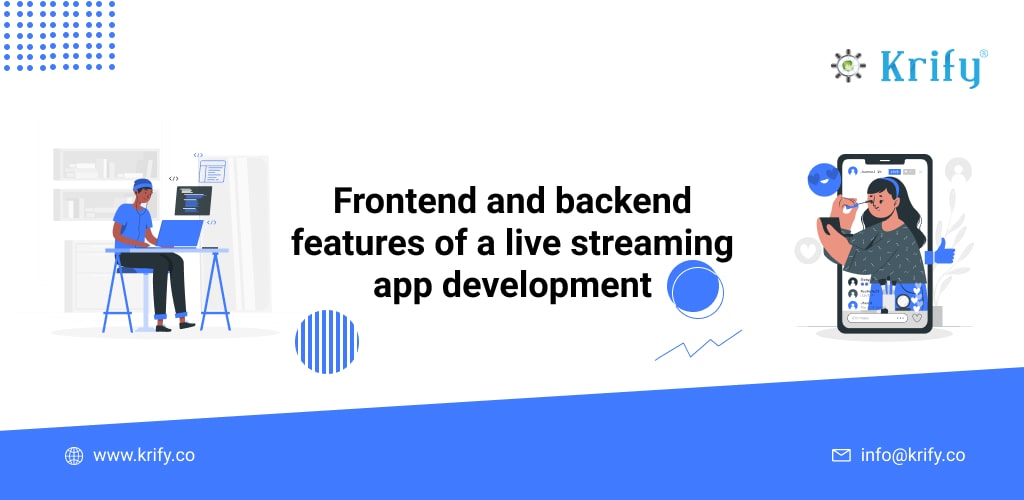As a result of the development of information technology, we are seeing significant changes in our thinking, interaction, work, and leisure. We’d like to talk about innovative technologies such as live streaming and then general concepts that revolutionized the mobile apps industry from the television market stage. In this article, I will provide some frontend and backend features of a live streaming app effectively.
When it comes to mobile app development, there are a lot of technicalities involved. We’ve outlined the most important points in this guide so you can understand how these services will benefit your company. With each live streaming software’s popularity, its usage grows. Our specialists assure that their solutions are simple to navigate and visually appealing in order to help you achieve the greatest results in a short amount of time.
Frontend Features of a Live Streaming App Development
1. Registration of Users:
This is one of the most important aspects of any media streaming software development. App Developers must offer a variety of registration and login choices to users. For example, they may pick a mobile phone for OTP verification, a Facebook account, or a Google account as an alternative option. Also, don’t forget to retain the ability for the user to retrieve their password if they inadvertently lose their credentials. Since it’s the first screen that app developers will show to the user, invest more effort in the UI of the registration and login page.
2. User Information:
It’s also useful for mobile app development companies to be able to modify and personalize user accounts. Developers can also acquire detailed information like users, subscribers, and video watched, among other things, through the Mobile App Platform. Also, keep the ability to post a recently viewed playlist of movies on social media open.
3. Privacy Preferences:
Although people typically want to share things on social media with their friends, they may require some privacy at times. As a result, remembering the stated fact, app developers must provide users the option to control who sees their preferences and which platforms they choose to broadcast them. App makers might also customize certain characteristics and allow users to select from a variety of individuals or any defined location or time.
4. Search Capability:
If the user wants to watch a video but does not know where to look for it or how to locate it, the search function comes in handy. Allow the user to search the whole database for a specific video. Instead of that, keep location-based filters (such as Most-watched), broadcast subjects (such as News), date (such as Today’s top stories), length (such as Top 10 most viewed videos today) genres, language, and top-rated movies under wraps. It will have an excellent impact if the user finds what he/she is looking for in a few seconds.

5. Interactive UX:
It is important to have a good user interface design in addition to the player so that it looks nice while viewing the video on full screen or half screen. The App users may customize it as they choose, from converting a complete screen to increasing or lowering the volume, changing the brightness levels, adding headphone settings with a switch. FLV, VR, and 360-degree videos should all be supported by the video player for a more immersive user experience.
6. Ratings and Reviews:
It’s critical to understand what your consumers think of your app. They may be completely pleased with it or have problems in one area. Your video streaming software developer must be aware of these comments and needs so that they can provide the appropriate help.
7. Screen Sharing:
The “share the screen” functionality is well-known among Skype users. This is simply displaying another person what he or she would see on the mobile device. It makes streaming movies easier than ever and reduces the difficulty of creating tutorials. Game tutorial sharing using a comparable method is simpler to do and broadcast.
Backend Features of a Live Streaming App Development
1. Streaming Video:
This is the app’s central theme, so make every effort to include all of the features. Stream from an external server at all times and keep the program as simple as feasible. The streaming signal travels via the server to the user device and remains there until the user starts viewing it. It is immediately deleted from the server after usage. The server will convert the broadcast before sending it to the application. Video streaming applications necessitate cloud servers.
2. Quality of the Stream:
This is one of the most crucial elements to consider while developing an on-demand video streaming app. It allows people to watch the video without interruption if the network bandwidth is restricted. The default setting should be maintained for image quality, which should be set to 144p and increased up to 1080p or 4k. Allow the program to select the video quality automatically based on available network bandwidth.
3. Subscriptions and Revenue Streams:
When the user opens the app, this component notifies them that new videos from their favorite band or performing team are available. It’s the ideal approach to engage your users with your software. If a broadcaster does not allow free subscriptions, it is vital to preserve the option to redirect visitors to in-app purchases via their website.
Conclusion:
The frontend and backend features of a live streaming app listed above are only intended to provide an image of what a live streaming app might look and function like. If you have your own concept for a video streaming application that you’d want to develop into reality, please contact us. Even if you have just an initial concept, we can discuss it further until it becomes an innovative mobile app. For more information, contact us.



